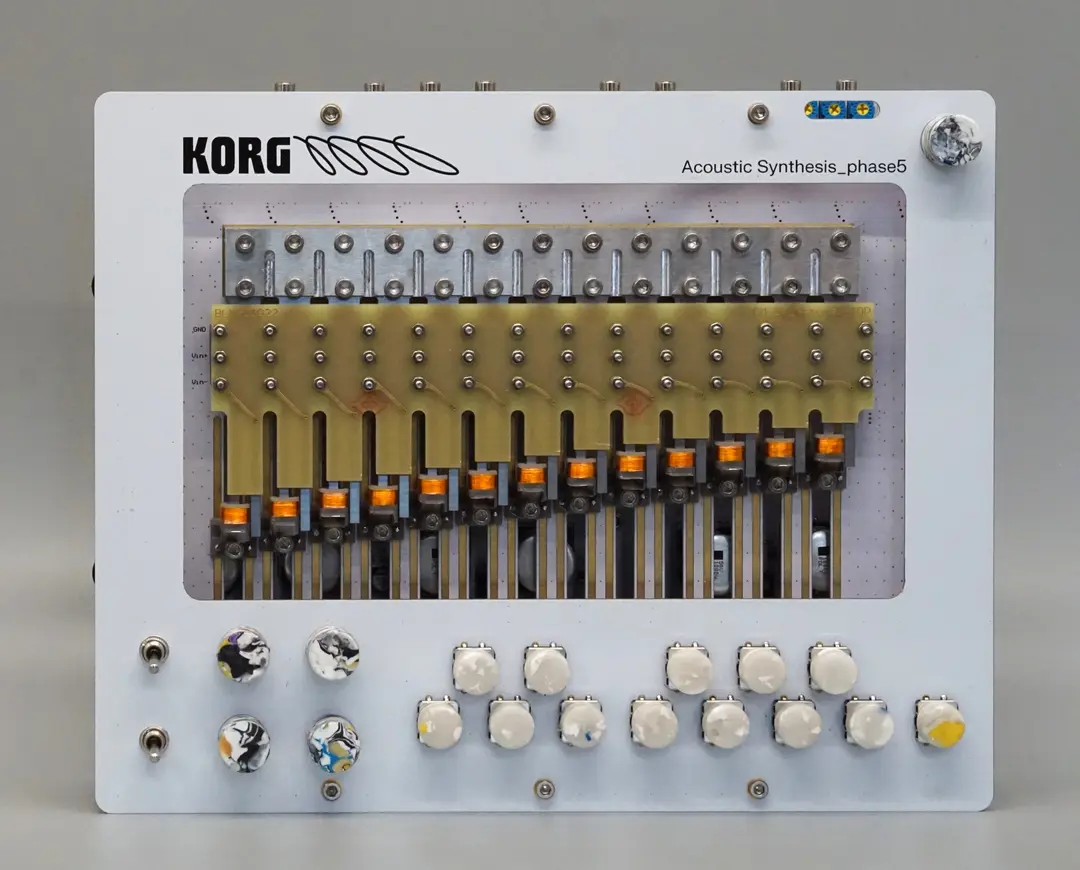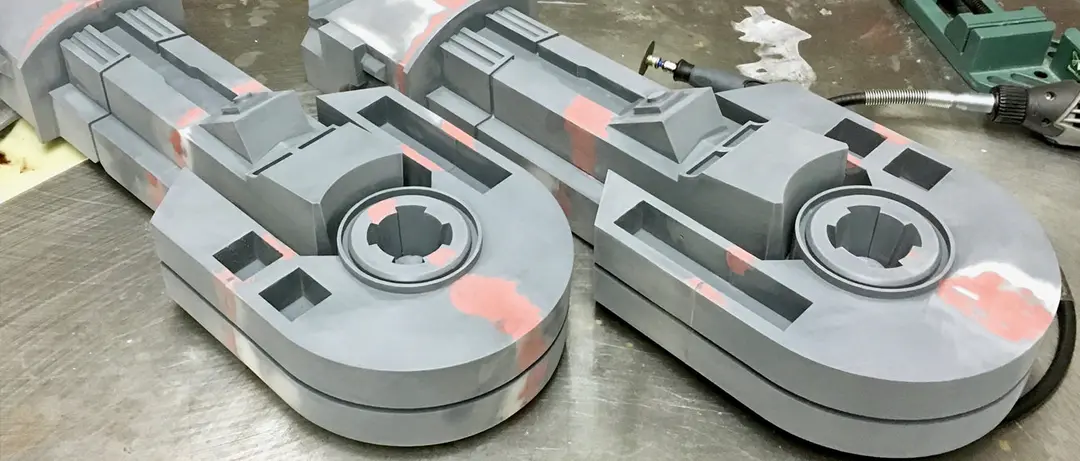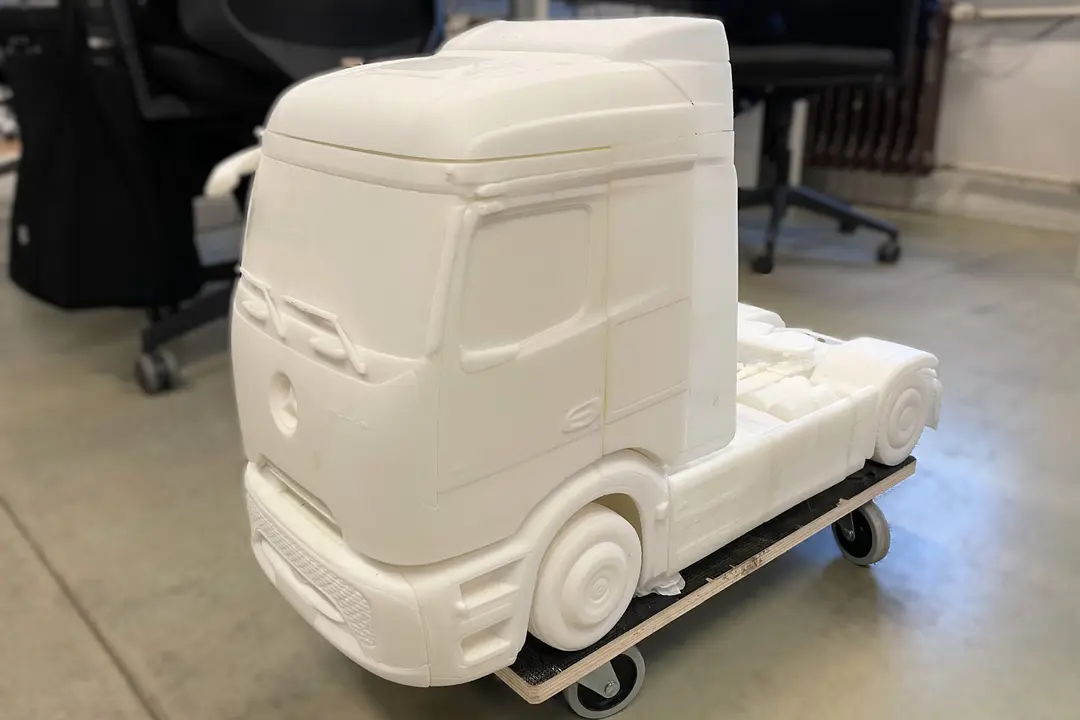Russell and Travis Bobbitt on the set of Avengers.
Without props, some of the largest Hollywood blockbusters would not exist. Russell Bobbitt, head of props at Marvel Studios, has over 30 years of experience in film design, lending his skills to blockbuster movies like Iron Man, Avengers, and Guardians of the Galaxy. As a prop master, Bobbitt is responsible for a lot of key items that appear on screen. “In the Marvel world, I'm responsible for Captain America’s Shield and Thor's Hammer and Iron Man’s Arc Reactors, the light that he wears on his chest, among other things,” Bobbitt said. But Bobbitt doesn’t just work on the standout pieces—essentially anything an actor touches, even doorknobs, are considered props.
Creating props requires incredible creativity, imagination, and precision. That’s where 3D printing comes into play. During the Formlabs User Summit, Bobbitt explained how he was able to leverage 3D printing at Marvel.
Introduction to 3D Printing for Film
Bobbitt was introduced to 3D printing by J.J. Abrams during his 2009 Star Trek reboot. Abrams wanted a policeman on a floating motorcycle to pull his prop ray gun. When Bobbitt asked for some guidance, Abrams said he had a 3D printer in his office. So Bobbitt got to work, collaborating with someone who was adept at CAD drawing to come up with a ray gun. “We sat and we drew the gun and he hit the print button,” Bobbitt said. “This was my introduction to 3D printing, it was with J.J. Abrams on Star Trek. We had the gun the next day. I had the painters quickly paint it and we used the [raygun] right off the machine. No molds, no casting, no nothing. In 24 hours after an idea that a genius filmmaker J.J. Abrams threw out there, it almost felt like it was testing us. Hey, let's have this for tomorrow. And sure enough, he knew, I think, in the back of his head that he'd be sending me to the 3D printer.”
At the time, 3D printers were not as accessible as they are now. Bobbitt recalls the first 3D printer he used with a hefty price tag of $150,000. He was so convinced that 3D printing would play an integral role in set design that he said, “I immediately dove in and started researching 3D printing and told all my illustrator friends who draw with pencils, you better go get yourself a computer.”
The 3D Printing Workflow for Creating Props
The set Russell Bobbitt created includes a Formlabs printer.
3D printing workflows differ for each industry and application. Bobbitt fine-tuned his workflow for the fast-paced entertainment industry. It all begins with reading a script. “Nine times out of 10, I have become the manufacturer person in the industry. And so they'll call me when there's a heavy load of manufacturing as opposed to a romantic comedy...What is a weapon going to look like in outer space 2,200 years from now? So I have to dream all that up,” Bobbitt explains. He makes a list of the important props and works with a team of illustrators to draw the props. Then he will pitch the sketches to the director. From there, Bobbitt and the director will decide on the sketches to turn into props. “And then once we get approved, we take it to the CAD world...We definitely need a good CAD drawing in order to put out a nice prototype and then make molds and cast and make rubber props for stunts and real ones and so on, so forth.”
This is followed by meeting with the actor to discuss any adjustments that need to be made. “Then I will take it to the manufacturing process once it's approved, the actor's comfortable with it, on our 3D printers, we will scale things out. So, for instance, Stormbreaker, the new Thor Hammer, we built that in 34 pieces, kind of assembled like a trophy,” Bobbitt said. Bobbitt worked directly with Chris Hemsworth to fit the Stormbreaker—with every prop, Bobbitt has to find the perfect scale.
3D printing significantly saves time for prop making and fuels creativity in the design process, by allowing for the creation of dozens of in-house prototypes. The design process becomes more flexible and fluid, and props can be created in an efficient manner.
“Then we print our final print and then go into production with it. So it's not just that we're making one prototype. We could make eight or ten prototypes so that we know exactly what is needed before we spend tons of money on very expensive silicones to make molds and casting and then it comes out wrong,” Bobbitt said. “In the old days, I would have a sculptor sculpting the props and he would sculpt a bigger one and then a smaller one and so on and so forth.”
The Future of 3D Printing in Entertainment
Bobbitt boasts over 30 years in the entertainment industry, and the changes through the years have been monumental. “We used to do films where we didn't have a cell phone, I had a pager and, you know, and now we have 3D printers,” he recalls.
3D printing played a transformative role in prop making. To Bobbitt, 3D printing is an everyday tool. “What we're finding is that more and more, as we learn about designing and drawing and printing, we are finding that more and more 3D printing is just an everyday event. It's a very useful tool. And so there is no getting around a brilliant idea. And the fact that they took an X and Y axis and added a Z [axis] to it, it was a life-changing moment for many, many industries.”
Bobbitt estimates using 3D printing to print about 100 props per film. “I'm working on five Marvel streaming shows right now and a feature film...I'm printing 200 props right now at any given time. So it's constant work,” he said.
With so many props to print, Bobbitt experiments with different materials. “We will print two to four in a hard resin. And then if there's a stunt with that prop, I'll print six to 10 in rubber so that if a stunt person has to roll or fall or hit somebody, you want to use a softer rubber.”
The future of 3D printing in entertainment is bright, according to Bobbitt. As a veteran in the industry, he’s frequently asked how to break into the business. The advice Bobbitt offers is, “If you have passion for this film business and you're an artist and you can draw a 3D CAD drawing like nobody's business, knock on doors, find people like me, get out there, and figure it out, depending on where you live, where the film industry is at the time...We go from California to Atlanta to Louisiana to South Carolina.”
Without a doubt, 3D printing is in high demand. Bobbitt added, “You can get out there and figure that out if you want to make a career.”


